
FM 21-150 COMBATIVES 1992
.pdf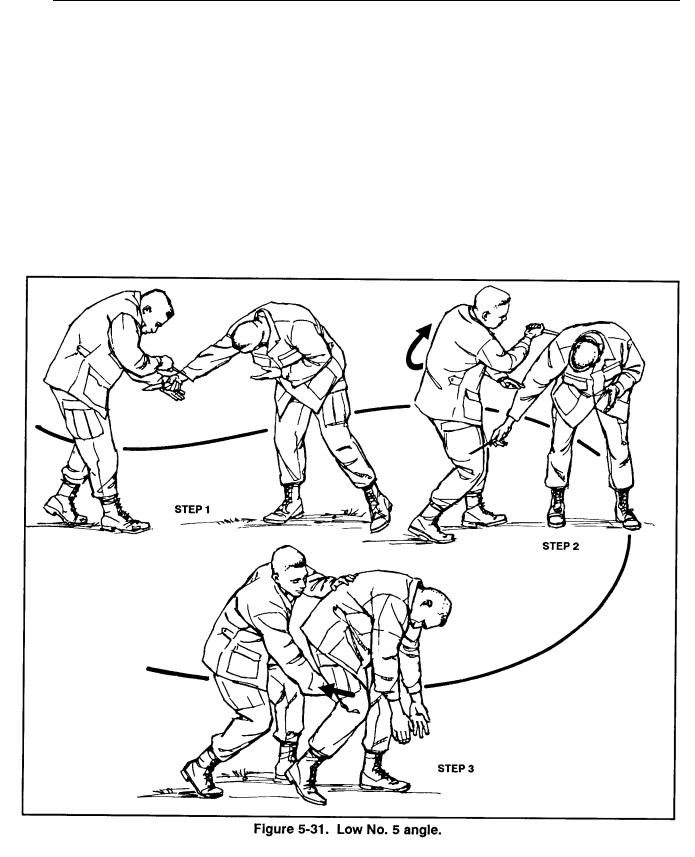
FM 21-150
c. Low No. 5 Angle. In the next sequence, the attacker on the right lunges to the stomach along a low No. 5 angle of attack.
The defender on the left moves his body off the line of attack while parrying and slashing the wrist of the attacking knife hand as he redirects the arm (Figure 5-31, Step 1).
After he slashes the wrist of his attacker, the defender continues to move around the outside and stabs the attacker’s armpit (Figure 5-31, Step 2).
He retracts his knife from the armpit, continues his movement around the attacker, and slices his hamstring (Figure 5-31, Step 3).
5-48
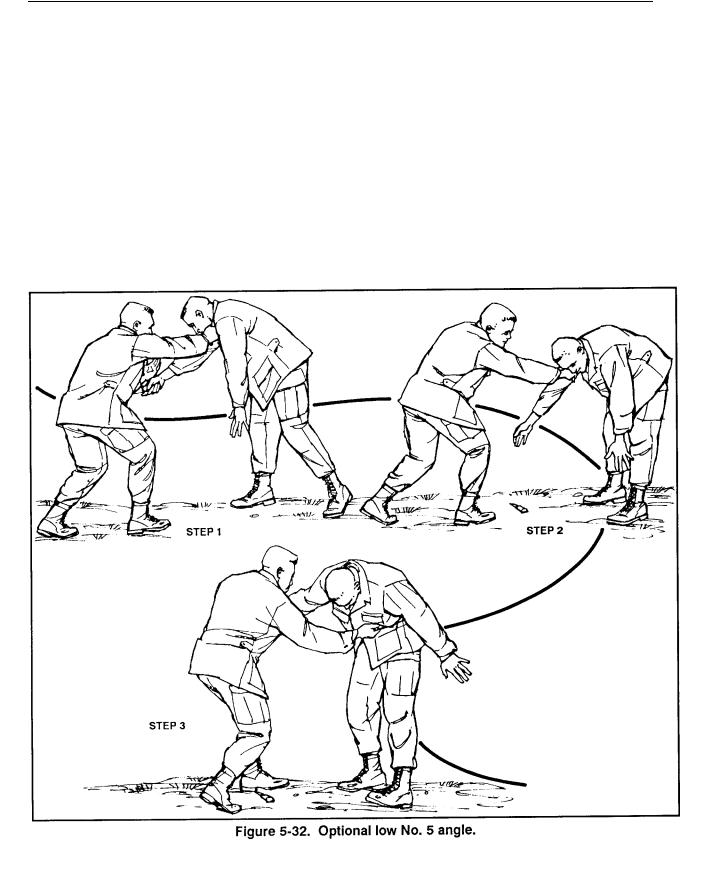
FM 21-150
d. Optional Low No. 5 Angle. The attacker on the right lunges to the stomach of his opponent (the defender) along the low No. 5 angle of attack. The defender moves his body off the line of attack of the knife. Then he turns and, at the same time, delivers a slash to the attacker’s throat along the No. 1 angle of attack (Figure 5-32, Step 1).
The defender immediately follows with another slash to the opposite side of the attacker’s throat along the No. 2 angle of attack (Figure 5-32, Step 2).
The attacker is finished as the opponent on the left (defender) continues to slice across the abdomen with a stroke along the No. 3 angle (Figure 5-32, Step 3).
5-49

FM 21-150
5-10. RIFLE WITH FIXED BAYONET
The principles used in fighting with the rifle and fixed bayonet are the same as when knife fighting. Use the same angles of attack and similar body movements. The principles of timing and distance remain paramount; the main difference is the extended distance provided by the length of the weapon. It is imperative that the soldier fighting with rifle and fixed bayonet use the movement of his entire body behind all of his fighting techniques—not just upper-body strength. Unit trainers should be especially conscious of stressing full body mass in motion for power and correcting all deficiencies during training. Whether the enemy is armed or unarmed, a soldier fighting with rifle and fixed bayonet must develop the mental attitude that he will survive the fight. He must continuously evaluate each moment in a fight to determine his advantages or options, as well as the enemy’s. He should base his defenses on keeping his body moving and off the line of any attacks from his opponent. The soldier seeks openings in the enemy’s defenses and starts his own attacks, using all available bodyweapons and angles of attack. The angles of attack with rifle and fixed bayonet are shown in Figures 5-33 through 5-39.
5-50
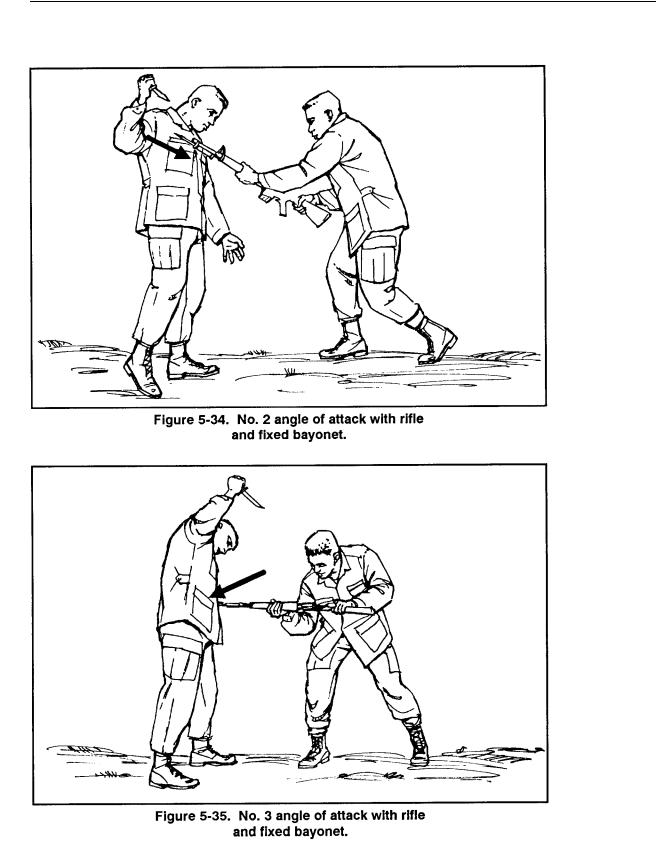
FM 21-150
5-51
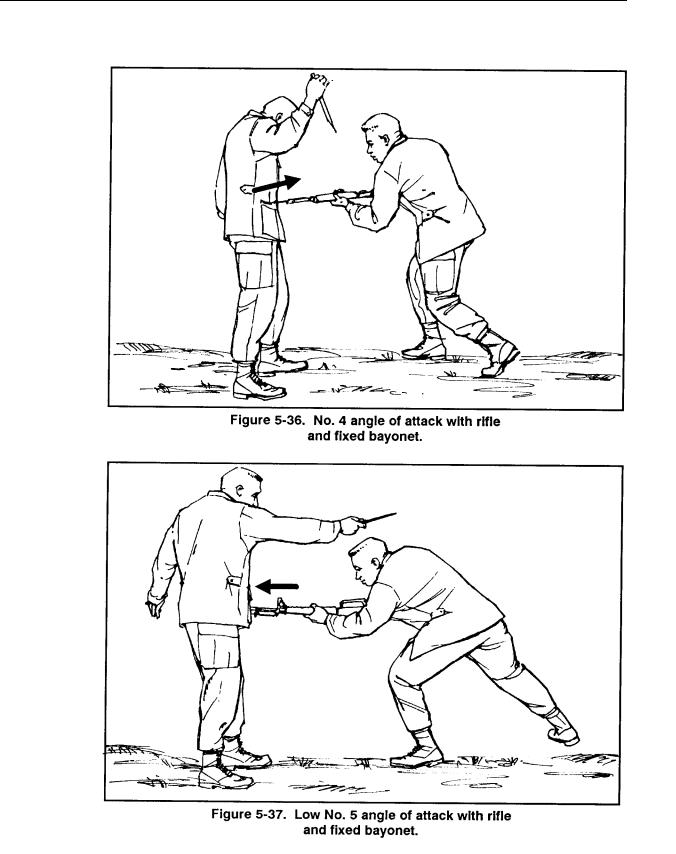
FM 21-150
5-52

FM 21-150
5-53

FM 21-150
a. Fighting Techniques. New weapons, improved equipment, and new tactics are always being introduced; however, firepower alone will not always drive a determined enemy from his position. He will often remain in defensive emplacements until driven out by close combat. The role of the soldier, particularly in the final phase of the assault, remains relatively unchanged: His mission is to close with and disable or capture the enemy. This mission remains the ultimate goal of all individual training. The rifle with fixed bayonet is one of the final means of defeating an opponent in an assault.
(1)During infiltration missions at night or when secrecy must be maintained, the bayonet is an excellent silent weapon.
(2)When close-in fighting determines the use of small-arms fire or grenades to be impractical, or when the situation does not permit the loading or reloading of the rifle, the bayonet is still the weapon available to the soldier.
(3)The bayonet serves as a secondary weapon should the rifle develop a stoppage.
(4)In hand-to-hand encounters, the detached bayonet may be used as a handheld weapon.
(5)The bayonet has many nonfighting uses, such as to probe for mines, to cut vegetation, and to use for other tasks where a pointed or cutting tool is needed.
b.Development. To become a successful rifle-bayonet fighter, a soldier must be physically fit and mentally alert. A well-rounded physical training program will increase his chances of survival in a bayonet encounter. Mental alertness entails being able to quickly detect and meet an opponent’s attack from any direction. Aggressiveness, accuracy, balance, and speed are essential in training as well as in combat situations. These traits lead to confidence,
coordination, strength, and endurance, which characterize the rifle-bayonet fighter. Differences in individual body physique may require slight changes from the described rifle-bayonet techniques. These variations will be allowed if the individual’s attack is effective.
c. Principles. The bayonet is an effective weapon to be used aggressively; hesitation may mean sudden death. The soldier must attack in a relentless assault until his opponent is disabled or captured. He should be alert to take advantage of any opening. If the opponent fails to present an opening, the bayonet fighter must make one by parrying his opponent’s weapon and driving his blade or rifle butt into the opponent with force.
(1)The attack should be made to a vulnerable part of the body: face, throat, chest, abdomen, or groin.
(2)In both training and combat, the rifle-bayonet fighter displays spirit by sounding off with a low and aggressive growl. This instills a feeling of confidence in his ability to close with and disable or capture the enemy.
5-54
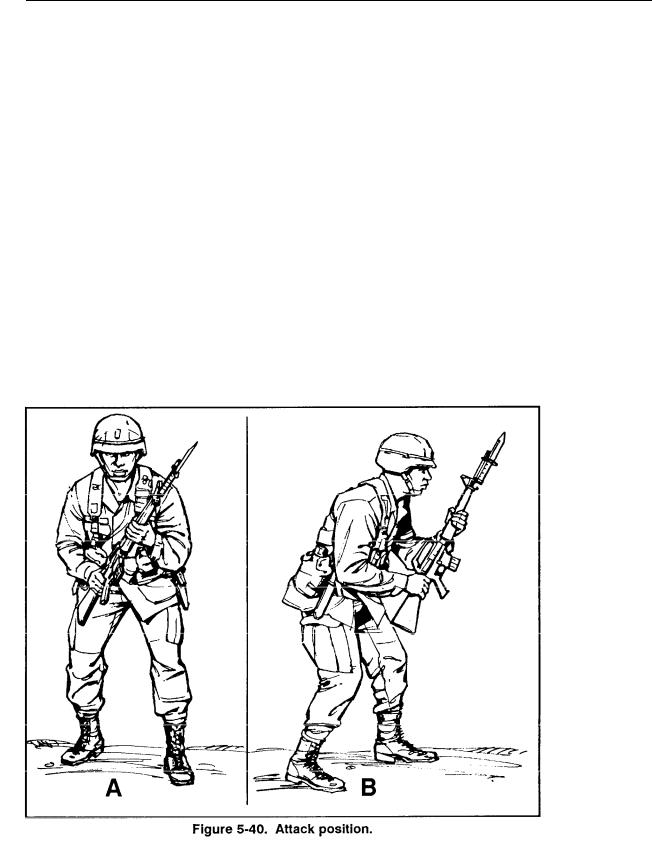
FM 21-150
(3) The instinctive rifle-bayonet fighting system is designed to capitalize on the natural agility and combatives movements of the soldier. It must be emphasized that precise learned movements will NOT be stressed during training.
d. Positions. The soldier holds the rifle firmly but not rigidly. He relaxes all muscles not used in a specific position; tense muscles cause fatigue and may slow him down. After proper training and thorough practice, the soldier instinctively assumes the basic positions. All positions and movements described in this manual are for right-handed men. A left-handed man, or a man who desires to learn left-handed techniques, must use the opposite hand and foot for each phase of the movement described. All positions and movements can be executed with or without the magazine and with or without the sling attached.
(1) Attack position. This is the basic starting position (A and B, Figure 5-40) from which all attack movements originate. It generally parallels a boxer’s stance. The soldier assumes this position when running or hurdling obstacles. The instructor explains and demonstrates each move.
5-55
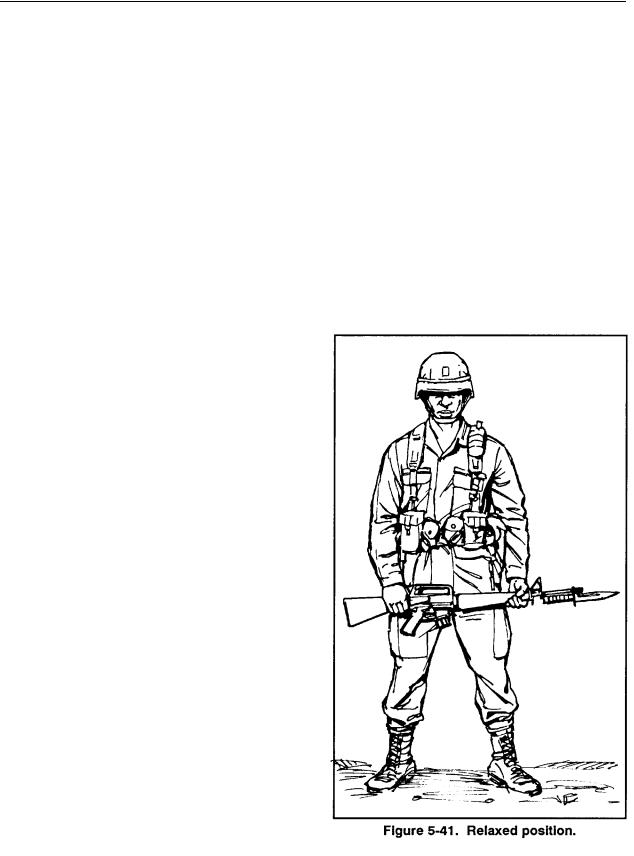
FM 21-150
(a)Take a step forward and to the side with your left foot so that your feet are a comfortable distance apart.
(b)Hold your body erect or bend slightly forward at the waist. Flex your knees and balance your body weight on the balls of your feet. Your right forearm is roughly parallel to the ground. Hold the left arm high, generally in front of the left shoulder. Maintain eye-to-eye contact with your opponent, watching his weapon and body through peripheral vision.
(c)Hold your rifle diagonally across your body at a sufficient distance from the body to add balance and protect you from enemy blows. Grasp the weapon in your left hand just below the upper sling swivel, and place the right hand at the small of the stock. Keep the sling facing outward and the cutting edge of the bayonet toward your opponent. The command is, ATTACK POSITION, MOVE. The instructor gives the command, and the soldiers perform the movement.
(2) Relaxed position. The relaxed position (Figure 5-41) gives the soldier a chance to rest during training. It also allows him to direct his attention toward the instructor as he discusses and demonstrates the positions and movements. To assume the relaxed position from the attack position, straighten the waist and knees and lower the rifle across the front of your body by extending the arms downward. The command is, RELAX. The instructor gives the command, and the soldiers perform the movement.
e. Movements. The soldier will instinctively strike at openings and become aggressive in his attack once he has learned to relax and has developed instinctive reflexes. His movements do not have to be executed in any prescribed order. He will achieve balance
5-56

FM 21-150
in his movements, be ready to strike in any direction, and keep striking until he has disabled his opponent. There are two basic movements used throughout bayonet instruction: the whirl and the crossover. These movements develop instant reaction to commands and afford the instructor maximum control of the training formation while on the training field.
(1) Whirl movement. The whirl (Figure 5-42, Steps 1,2, and 3), properly executed, allows the rifle-bayonet fighter to meet a challenge from an opponent attacking him from the rear. At the completion of a whirl, the rifle remains in the attack position. The instructor explains and demonstrates how to spin your body around by pivoting on the ball of the leading foot in the direction of the leading foot, thus facing completely about. The command is, WHIRL. The instructor gives the command, and the soldiers perform the movement.
(2) Crossover movement. While performing certain movements in rifle-bayonet training, two ranks will be moving toward each other. When the soldiers in ranks come too close to each other to safely execute additional movements, the crossover is used to separate the ranks a safe distance apart. The instructor explains and demonstrates how to move straight forward and
5-57
